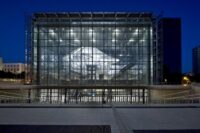- Home
- Articles
- Architectural Portfolio
- Architectral Presentation
- Inspirational Stories
- Architecture News
- Visualization
- BIM Industry
- Facade Design
- Parametric Design
- Career
- Landscape Architecture
- Construction
- Artificial Intelligence
- Sketching
- Design Softwares
- Diagrams
- Writing
- Architectural Tips
- Sustainability
- Courses
- Concept
- Technology
- History & Heritage
- Future of Architecture
- Guides & How-To
- Art & Culture
- Projects
- Interior Design
- Competitions
- Jobs
- Store
- Tools
- More
- Home
- Articles
- Architectural Portfolio
- Architectral Presentation
- Inspirational Stories
- Architecture News
- Visualization
- BIM Industry
- Facade Design
- Parametric Design
- Career
- Landscape Architecture
- Construction
- Artificial Intelligence
- Sketching
- Design Softwares
- Diagrams
- Writing
- Architectural Tips
- Sustainability
- Courses
- Concept
- Technology
- History & Heritage
- Future of Architecture
- Guides & How-To
- Art & Culture
- Projects
- Interior Design
- Competitions
- Jobs
- Store
- Tools
- More
The Harmonious Blend of Art and Architecture: Shaping Culture and Space
Discover the intricate relationship between art and architecture in our latest article, which explores their cultural significance and transformative power over time. From ancient structures like the Pyramids of Giza to modern sustainable designs, learn how these fields reflect societal values and inspire innovation.

Art and architecture have always been intertwined, shaping our environments and influencing our senses. From the grand cathedrals of the past to contemporary installations, these two disciplines reflect cultural values and societal changes. As we explore their connection, we’ll uncover how artistic expression transforms spaces and how architecture serves as a canvas for creativity.
In every corner of the world, we find stories told through structures and sculptures. Whether it’s the intricate details of a Gothic cathedral or the sleek lines of modern design, art and architecture invite us to engage with our surroundings in profound ways. Join us as we delve into this fascinating relationship, celebrating the beauty and innovation that arise when these two worlds collide.

Table of Contents
ToggleOverview of Art and Architecture
Art and architecture intertwine to create environments that influence our daily lives. They reflect and shape cultural values, transforming spaces into expressions of identity and creativity.

Definition of Art and Architecture
Art encompasses a wide range of human activities, including painting, sculpture, and performance, aimed at expressing creativity and emotions. Architecture refers to the design and construction of buildings and structures, combining functionality and aesthetics. Together, art and architecture represent diverse expressions of human thought, interpreting cultural narratives through visual means.
Significance in Culture
Art and architecture play essential roles in culture, embodying shared values and beliefs. They serve as historical records, preserving the evolution of societies through forms, styles, and materials. Notable examples include:
- Cathedrals: Structures like the Notre-Dame showcase religious devotion and architectural innovation.
- Public sculptures: Works like the “Cloud Gate” in Chicago spark conversation and identity within communities.
- Museums: Institutions such as the Louvre blend art and architecture, creating spaces for cultural engagement.
Understanding these interactions enriches our appreciation of the world around us and informs our collective identity.
Historical Context
Art and architecture have roots that stretch back to ancient civilizations and continue to evolve through prominent historical periods. We can trace the influence of these elements across time, revealing their impact on culture and society.

Ancient Civilizations
Ancient civilizations such as Mesopotamia, Egypt, Greece, and Rome laid foundational principles for art and architecture. We observe monumental structures like the Pyramids of Giza, which reflect advanced engineering and deep religious beliefs. In Greece, we see the construction of classical temples like the Parthenon, showcasing a harmonious blend of form and function, with intricate sculptures illustrating mythological narratives. Rome’s architectural innovations, including the Colosseum and aqueducts, demonstrate the capacity to combine practicality with artistic ambition. These civilizations used art and architecture not only for aesthetic purposes but also to communicate power, spirituality, and societal values.
Renaissance Period
The Renaissance marked a significant revival of classical ideas, fueling advancements in both art and architecture. We witness a surge of creativity from artists and architects like Leonardo da Vinci, Michelangelo, and Filippo Brunelleschi. They emphasized humanism, proportion, and perspective, transforming structures into masterpieces. Notable examples include St. Peter’s Basilica, which harmonizes grandiosity with intricate detail, and Michelangelo’s iconic frescoes in the Sistine Chapel. This period redefined the relationship between the two disciplines, establishing a legacy that influenced later movements and set high standards for artistic excellence and architectural innovation.
Key Movements in Art and Architecture
Art and architecture have evolved through several key movements, each leaving a distinct mark on our cultural landscape. Understanding these movements allows us to appreciate the rich narrative woven into our built environment.

Baroque Art and Architecture
Baroque art and architecture emerged in the late 16th century and flourished until the early 18th century. This movement is characterized by grandeur, drama, and movement. Artists and architects like Gian Lorenzo Bernini and Francesco Borromini revolutionized design with intricate details and dynamic forms.
Notable examples include St. Peter’s Basilica in Vatican City and the Palace of Versailles in France. These structures demonstrate a blend of theatricality and spatial complexity, enhancing emotional engagement. The use of light, shadow, and rich colors further emphasizes the dramatic impact, creating immersive experiences that draw viewers into the artwork and architecture.
Modernism and Its Impact
Modernism arose in the late 19th and early 20th centuries as a response to industrialization and traditional styles. This movement emphasizes minimalism, function, and new materials, shifting the focus toward innovation and abstraction. Key figures, including Le Corbusier and Frank Lloyd Wright, sought to redefine architectural forms, promoting simplicity and integration with nature.
Iconic structures such as the Villa Savoye and the Fallingwater exemplify modernist principles. These designs prioritize open spaces, merging indoor and outdoor environments seamlessly. The influence of modernism extends beyond aesthetics; it reshaped urban landscapes and informed contemporary design philosophies, laying the groundwork for future movements like postmodernism and sustainable architecture.
Notable Artists and Architects
Art and architecture both flourish through the work of influential individuals. Their contributions define eras and inspire future generations.

Influential Art Figures
- Pablo Picasso
Picasso revolutionized modern art, co-founding the Cubist movement. His diverse styles, including the Blue and Rose periods, emphasized emotional depth and innovative techniques. Notable works include Les Demoiselles d’Avignon and Guernica, which challenge traditional perceptions.
- Frida Kahlo
Kahlo’s personal and imaginative approach to painting delved into themes of identity, pain, and femininity. Her vibrant use of color and symbolism, as seen in The Two Fridas and Self-Portrait with Thorn Necklace and Hummingbird, creates a dialogue with cultural heritage.
- Georgia O’Keeffe
O’Keeffe is known for her bold, large-scale flower paintings and striking landscapes of New Mexico. Her work captures the essence of natural beauty, merging abstraction and representation. Pieces like Black Iris III showcase her distinctive style.
- Andy Warhol
Warhol’s mastery of pop art transformed the cultural landscape. His use of repetition and commercial imagery, as seen in works like Campbell’s Soup Cans and Marilyn Diptych, questions the boundaries between high art and consumerism.
Renowned Architects
- Frank Lloyd Wright
Wright pioneered organic architecture, emphasizing harmony between buildings and their environment. His designs, such as Fallingwater and the Guggenheim Museum, integrate natural elements and innovative forms, reshaping American architecture.
- Le Corbusier
Le Corbusier is a key figure in modern architecture, known for his functionalist approach. His urban planning and designs, including Villa Savoye and the Unité d’Habitation, prioritize human needs and social living, influencing contemporary architecture.
- Zaha Hadid
Hadid broke barriers in architecture with her futuristic designs characterized by fluid forms and dynamic lines. Landmark projects, like the Guangzhou Opera House and the London Aquatics Centre, exemplify her visionary architectural style.
- I.M. Pei
Pei’s elegant and modern structures blend tradition and innovation. Notable works, such as the Louvre Pyramid and the Bank of China Tower, reflect his ability to integrate architecture with cultural context and modern functionality.
Contemporary Trends
Contemporary art and architecture reflect evolving societal values, with sustainability and digital innovation at the forefront. These trends not only reshape our built environments but also influence artistic expressions.

Sustainability in Art and Architecture
Sustainable practices in art and architecture focus on minimizing environmental impact. Architects integrate eco-friendly materials, energy-efficient systems, and green spaces into designs. Examples include the Bosco Verticale in Milan, which incorporates biodiversity through vertical gardens, and the HiFi building in Norway, featuring a low-carbon footprint due to its use of timber. Artists also embrace sustainability, using recycled materials and methods to create works that raise awareness. The “Trash People” installation by HA Schult showcases this impact, transforming waste into thought-provoking art. As we prioritize ecology, the collaboration between artists and architects fosters innovative solutions that contribute to a sustainable future.
Digital Art and Architecture
Digital technologies transform traditional art and architecture practices, introducing new forms of creativity and design capabilities. Artists leverage digital tools, such as virtual reality (VR) and augmented reality (AR), to create immersive installations. Projects like TeamLab Borderless in Tokyo demonstrate digital art that merges environments with audiences. Architecture also benefits from digital advancements. Computer-aided design (CAD) and generative design techniques allow architects to envision complex structures with precision. Notable examples include the Elbphilharmonie in Hamburg, showcasing cutting-edge design through digital modeling. As digital trends merge with creativity, they redefine contemporary artistic and architectural landscapes, shaping how we experience spaces and art.
Conclusion
Art and architecture continuously shape our environments and reflect our cultural values. They engage us through transformative spaces, showcasing creativity in various forms. The intricate relationship between these fields reveals our shared human experiences and aspirations.
We recognize art as an extensive range of expressive activities, while architecture embodies the thoughtful design and functionality of buildings. Together, they serve as vital markers of our historical evolution, conveying societal values and beliefs through notable structures, such as cathedrals, public sculptures, and museums.
By tracing the historical context, we see how ancient civilizations laid the groundwork for art and architecture, with monumental achievements exemplifying advanced engineering. The Renaissance period revitalized classical ideas, emphasizing the deep connections between artists and architects, and established legacies that continue to inform contemporary creativity.
Key movements like Baroque and Modernism have significantly influenced our cultural landscape. Baroque’s grandeur contrasts with Modernism’s minimalist approach, illuminating how these styles profoundly reshaped urban environments and architectural thought. Renowned artists and architects, such as Picasso and Wright, have left lasting impressions that inspire our ongoing exploration of these intertwined disciplines.
In today’s context, trends in sustainability and digital innovation reflect the evolution of our collective values. Architects and artists integrate eco-friendly practices and materials in their work, addressing pressing environmental concerns while enhancing aesthetic appeal. The incorporation of digital technologies elevates artistic expression and architectural complexity, pushing boundaries and reimagining experiences within our spaces.
We celebrate the synergy between art and architecture, recognizing their power to enrich our understanding of the world and each other.
- architectural art consultants
- architectural design services
- art and architecture firm
- art inspired architecture
- art-centric architectural firm
- artistic architectural solutions
- artistic interior architecture
- blending art and architecture
- creative structural design
- Cultural Architecture
- cultural space design
- custom art installations
- heritage building design
- innovative space design
- museum architecture design
- public art spaces
I create and manage digital content for architecture-focused platforms, specializing in blog writing, short-form video editing, visual content production, and social media coordination. With a strong background in project and team management, I bring structure and creativity to every stage of content production. My skills in marketing, visual design, and strategic planning enable me to deliver impactful, brand-aligned results.
Submit your architectural projects
Follow these steps for submission your project. Submission FormLatest Posts
Understanding Site Safety Footwear in Architectural Practice
Architecture is often discussed through drawings, models, and finished buildings, yet a...
General Arrangement Drawings in Architecture: The Backbone of Clear Design Communication
General Arrangement Drawings explained: what they are, when to use them, how...
The Ultimate Guide to Fencing in North Dakota: Choosing the Best Fence for Your Property
Watching a chain link fence twist in 70 mph winds near Minot...
Gaudí: Where Architecture Meets Science
Gaudí: Where Architecture Meets Science shows catenary arches, ruled surfaces, and biomimicry...












Leave a comment